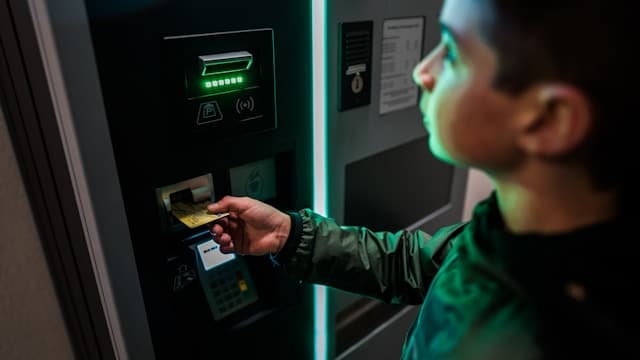The humble Automated Teller Machine (ATM) has been a cornerstone of banking infrastructure for over half a century. In the United States alone, there are more than half a million ATMs currently in use, serving as a crucial financial access point, especially for individuals relying heavily on cash transactions. While digital payments and mobile banking continue to reshape financial services, ATM networks are far from obsolete. Instead, they are evolving to meet changing consumer needs and technological capabilities, bridging the gap between physical and digital banking.
The Evolution of ATM Technology
Modern ATMs bear little resemblance to their early predecessors, which could only dispense cash and provide basic account information. Today’s machines are sophisticated financial kiosks that integrate advanced security features, real-time connectivity, and an expanding range of services from basic banking to crypto trading. The evolution of these networks reflects broader trends in financial technology, including enhanced connectivity, improved security measures, and greater accessibility.
Biometric authentication represents one of the most significant advances in ATM security. Rather than relying solely on PINs and cards, many modern ATMs can verify users through fingerprint scanning, facial recognition, or iris scanning. These technologies not only enhance security but also improve user experience by eliminating the need to remember PINs or carry physical cards.
Bridging Digital and Physical Banking
As financial services become increasingly digital, ATMs are evolving to serve as bridges between physical and virtual banking worlds. The emergence of cryptocurrency ATMs has created new opportunities for financial accessibility, with a network of Bitcoin ATMs enabling convenient access to digital currency transactions in locations worldwide. This integration of traditional ATM infrastructure with cryptocurrency services demonstrates how these networks are adapting to serve emerging financial needs.
The integration of mobile technology with ATM networks has created new possibilities for convenient banking. Users can now initiate transactions on their smartphones and complete them at ATMs without inserting a card, reducing transaction times and improving security. Some systems allow customers to pre-stage withdrawals through mobile apps, making the ATM interaction as simple as scanning a QR code.
Beyond cardless entry, banks can deploy dynamic, branded QR codes that launch secure sessions for withdrawals, deposits, digital receipts, or support flows. Using efficient QR code tools, teams can create and manage codes at scale, update destinations without reprinting, and analyze scan activity by branch and device to optimize operations and user experience.
Financial Inclusion and Accessibility
ATM networks play a crucial role in financial inclusion efforts worldwide. As of 2021, the number of ATMs per 100,000 adults varied significantly, with high-income countries maintaining higher ATM densities compared to low-income nations. In regions where traditional banking infrastructure is limited, ATMs serve as primary points of financial access. The evolution of these networks includes features designed to serve diverse populations, such as voice guidance for visually impaired users, wheelchair accessibility, and multi-language support.
Solar-powered ATMs and mobile ATM units have emerged as solutions for reaching underserved communities, particularly in rural areas with unreliable power infrastructure. These innovations demonstrate how ATM technology can adapt to local conditions while maintaining security and reliability standards.
Environmental Considerations
The banking industry’s focus on sustainability has influenced the evolution of the ATM network. Modern machines incorporate energy-efficient components and power management systems that reduce electricity consumption during periods of inactivity. These smart power management features include automated shutdown of idle components, LED lighting replacements, and optimized cooling systems that activate only when necessary.
Cash recycling ATMs, which can accept deposits and reuse the same cash for withdrawals, reduce the frequency of cash transportation, lowering both costs and environmental impact. This innovation has significantly decreased the carbon footprint of ATM operations by reducing the number of armored vehicle trips needed for cash replenishment. The recycling capability also extends the lifecycle of banknotes, reducing the need for new currency printing and disposal of worn bills.
Digital receipt options have further enhanced environmental efforts, giving customers the choice to receive transaction records electronically rather than on paper. Some ATMs now feature paperless marketing through digital displays instead of printed materials, while others use recycled and biodegradable materials for necessary components.
Remote monitoring and predictive maintenance systems have also contributed to sustainability goals. These technologies allow service teams to diagnose issues remotely and plan maintenance trips more efficiently, reducing unnecessary travel and the associated carbon emissions. Additionally, end-of-life ATM components are increasingly being recycled or repurposed through specialized e-waste management programs, ensuring that retired machines don’t contribute to landfill waste.
The Role of Artificial Intelligence
Artificial intelligence and machine learning are reshaping ATM network operations. These technologies enable predictive maintenance, helping operators identify potential issues before they cause service interruptions. AI algorithms can also optimize cash management by predicting usage patterns and ensuring optimal cash levels at each location.
Smart ATMs can adapt their interfaces based on user preferences and behavior patterns, providing personalized experiences that reflect individual banking habits. This capability extends to fraud detection, where AI systems can identify unusual patterns and potential security threats in real time.
Challenges and Considerations
Despite technological advances, ATM networks face several challenges. Cybersecurity remains a constant concern, requiring continuous updates and improvements to protect against evolving threats. The cost of maintaining and upgrading ATM networks must be balanced against the push toward digital banking services.
The challenge of network downtime and service interruptions poses another significant concern, as even brief outages can severely impact customer trust and accessibility. ATM operators must also navigate complex regulatory requirements across different jurisdictions, particularly when implementing new features or expanding into new markets.
Physical security also remains crucial, particularly for machines in remote locations. Advanced surveillance systems and anti-tampering mechanisms are essential components of modern ATM security infrastructure.
Looking Ahead
The future of ATM networks lies in their ability to adapt to changing financial landscapes while maintaining their core role in providing physical access to financial services. As cryptocurrency adoption grows, some ATMs are being equipped to handle digital currency transactions, suggesting a potential evolution in their fundamental purpose.
The integration of ATMs with broader digital banking ecosystems will continue, enabling new services such as government document processing and automated loan applications. However, the ATM network of tomorrow must balance innovation with accessibility, ensuring technological advances serve all users effectively. As financial services evolve, ATMs remain vital infrastructure components, adapting to meet new challenges while maintaining their essential role in serving diverse populations worldwide.




Leave a Reply